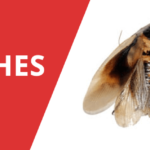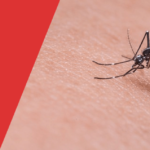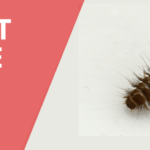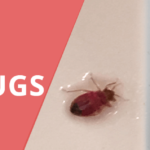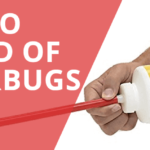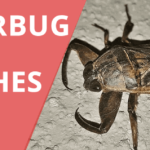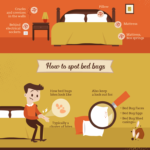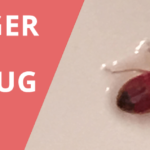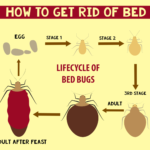If you see baby roaches in your home what does it indicate?
It shows that you have a major problem. Baby roaches are a sign of severe pest infestation, and you are going to be seeing many more if you do not take immediate steps to stop their growth. In this article, you will find detailed information about baby roaches and the best way to get rid of them permanently.
What Are Baby Roaches?
 Baby roaches come from eggs that are laid by female cockroaches. Each egg contains not one but 16 or more cockroaches depending on their species. For example, an egg of German roaches can hold up to 60 eggs.
Baby roaches come from eggs that are laid by female cockroaches. Each egg contains not one but 16 or more cockroaches depending on their species. For example, an egg of German roaches can hold up to 60 eggs.
The eggs hatch when the hatchlings inside try to expand themselves. When they emerge from the egg, these hatchlings are bright white. They are called nymphs and are very small in size. However, they turn darker in just a few hours.
At this stage, baby roaches look like ants or termites. Their white color and small size allow them to move around the house without being detected. At this stage, they can easily get inside pantries and containers with small openings and contaminate food.
Physical Appearance of Baby Roaches
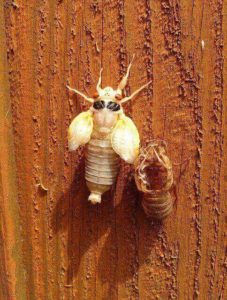 At the time of birth, baby roaches are only 3mm in length. Unlike adult cockroaches, baby roaches do not have any markings and are smooth in appearance. They have soft bodies that harden over time. Similar to the adult cockroaches, baby roaches have a head, small legs, and a pair of antennas. However, they grow quickly going through a few shedding phases before reaching maturity at around 40-160 days after birth.
At the time of birth, baby roaches are only 3mm in length. Unlike adult cockroaches, baby roaches do not have any markings and are smooth in appearance. They have soft bodies that harden over time. Similar to the adult cockroaches, baby roaches have a head, small legs, and a pair of antennas. However, they grow quickly going through a few shedding phases before reaching maturity at around 40-160 days after birth.
As baby roaches grow, they get quite large, change color, and have different markings depending on their type. Baby roaches do not have wings; therefore they cannot fly. They crawl around in the shadows not preferring to come out in daylight. They also like to stay close to the place where they hatched until they develop wings and can go further to look for food. The nymphs like to hide in places that offer proper temperature, food, and moisture.
Molting
A baby roach sheds its skin many times before it reaches maturity. This process is called molting and the number of molts a baby roach goes through depends on species and outside factors. These molts can range from 4 to 14 times; therefore, size differences can be drastic.
Roaches In Our Homes
 Most cockroaches are subtropical or tropical and as a result, prefer to live outdoors. However, some species have adapted to living with humans and can be found in our homes. It is a common misconception that cockroaches only infest dirty houses. Although cockroaches thrive in grimy, clutter-filled spaces, they are also known to invade even the most well-organized and cleanest spaces and homes.
Most cockroaches are subtropical or tropical and as a result, prefer to live outdoors. However, some species have adapted to living with humans and can be found in our homes. It is a common misconception that cockroaches only infest dirty houses. Although cockroaches thrive in grimy, clutter-filled spaces, they are also known to invade even the most well-organized and cleanest spaces and homes.
Roaches enter our homes through bags, boxes, dried pet food, and used furniture. They also invade our houses through open windows and doors, sewage and water pipes, and over electrical lines. These pests usually make their homes in dark, humid, and warm places and often reside in cracks under, around, and inside cabinets and cupboards especially in the bathroom or kitchen.
Types of Baby Roaches
 There are more than 3,500 species of cockroaches in the world, but only a few are known to live in buildings and homes. All cockroaches grow by gradual metamorphosis regardless of their species.
There are more than 3,500 species of cockroaches in the world, but only a few are known to live in buildings and homes. All cockroaches grow by gradual metamorphosis regardless of their species.
They have three life stages – egg, nymph, and adults. During the reproduction phase, adult females produce tiny, bean-shaped egg capsules that are glued or dropped onto a surface as soon as they are formed. The common types of roaches found inside the house are:
What Do Baby Roaches Look Like?
Most female cockroaches drop the egg sack on a surface where they hatch. Once these eggs hatch on the surface nymph cockroaches emerge from them. Though the nymphs share similar physical features with adult cockroaches, they are relatively smaller and don’t have fully developed wings. Their body is long and flattened with prickly legs that help them to run faster and squeeze into tiny crevices and spaces. Baby roaches also have a different coloring as compared to their adults.
Before maturing into adults, nymphs molt several times. The time required for an adult cockroach to complete its life cycle depends on its water and food sources and its environmental conditions. It can range from two months to three years.
Health Risks With Baby Roaches
Baby roaches leave behind traces of their existence wherever they go. They contaminate the environment by leaving bacteria and droppings around your home along with antibiotic-resistant strains. These bacteria can cause dysentery, diarrhea, and food poisoning. Cockroaches molt several times during their lifespan. They leave behind parts of their body that can be a major cause of asthma, allergies, and other breathing problems.
You might be suffering from a roach allergy if you have a skin rash, stuffy nose that just won’t clear, and year-round respiratory symptoms such as wheezing, chest tightness, and coughing. Cockroaches can also cause Typhoid and Polio.
What Are White Cockroaches?
It is very rare to spot a white cockroach; however white cockroaches are not rare at all. Every cockroach turns white various times at different stages of its life. Typically, cockroaches are white when they hatch or after they have molted. This is the stage when their outer skin or exoskeleton has not set yet and has to turn dark. After hatching or molting it might take several hours for their skeleton to darken in color and harden.
When roaches molt they not only shed their outer skin, they lose most of the pigmentation in their body. This is a chemical reaction that takes place in the body, and it usually takes a few hours to restore pigmentation.
Why Are White Cockroaches Hard to Spot?
White roaches are highly vulnerable to attacks by predators and drying out just after molting. We do not see white roaches too often because they stay hidden out of moving air and light to protect themselves from injuries and predators. Without their hardened protective exoskeleton it is very difficult for them to move around freely and quickly. Therefore, they keep out of sight to keep alive while they are white.
How to Get Rid OF Baby Roaches
 The process of getting rid of baby roaches is similar to that of getting rid of adult roaches. Whether the roaches are in the kitchen, bedroom, or bathroom, the same method will work to exterminate them. By using the following methods, you can effectively get rid of baby roaches in your home.
The process of getting rid of baby roaches is similar to that of getting rid of adult roaches. Whether the roaches are in the kitchen, bedroom, or bathroom, the same method will work to exterminate them. By using the following methods, you can effectively get rid of baby roaches in your home.
Use Roach Traps
It is suggested by experts that before spraying insecticide or laying down powders, you should use traps. When you catch the roaches with these traps, you will get a better idea of how big the nest is. If you do not catch any roaches, you can place the trap in another location to find out exactly from where they are coming from. Once you find out the location of the nest, you can use insecticides and sprays.
Make Your Own Cockroach Bait with Boric Acid
Mix one part sugar and three parts boric acid and sprinkle it under the stove and dishwasher, behind the refrigerator, in the cracks along the edges of pantries and cabinets, and under the sink. The sugar attracts the roaches while boric acid eliminates them. Although boric acid is not harmful to pets or people it can cause irritation in some cases; therefore, it is best to keep Cockroach Bait away from the reach of pets and children.
Bring In the Experts
If you have got a big roach infestation and you want to get rid of them, naturally you can hire an exterminator. They have the skills, knowledge, and tools that help them find the nest and exterminate them. Most exterminators use chemical sprays and poisons to get rid of roaches.
Try to find a pest company that uses safe, natural methods such as diatomaceous earth to get rid of roaches. Diatomaceous earth, a soft sedimentary rock, can be easily crushed into fine powder. This acts as a mechanical insecticide as it causes the roaches to die without using any chemicals and is completely safe for your family.
Keep your home clean
Cockroaches are attracted to food residue especially grease. If you eliminate food, there will be no reason for them to stick around.
- Keep all food in airtight containers and Ziploc bags. Don’t leave food open, lying around.
- Don’t leave dirty dishes in the sink.
- Take out the trash regularly.
- Wipe down counters especially after preparing food or eating.
- Clean thoroughly behind and underneath the appliances.
- Sweep the floor before going to bed.
Seal up holes and cracks
Baby roaches can crawl through the tiniest of places. Therefore, it is important to seal the entries to your home and the cracks between the countertop and walls, in the baseboards, and inside the pantry. You can use a caulking gun and tube of caulk for this job.
Fix water leaks

Roaches are attracted to water from leaks in the pipes and moisture. That is why you can often find them under the sink. Although roaches can survive for days without food, they cannot survive without water. You can close off their water supply by repairing leaky pipes. You should also take care not to let water stand in the sink and don’t overwater indoor plants.

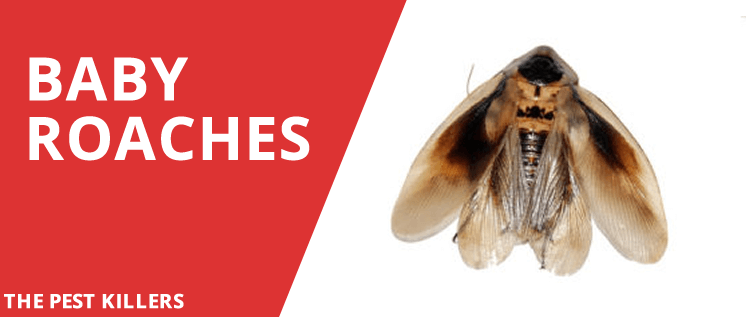
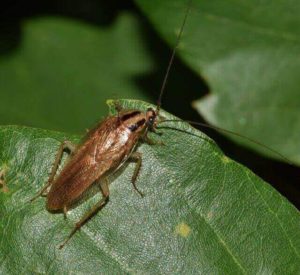 German cockroaches are the smallest species of cockroaches measuring just ½ to 5/8 of an inch in length. Although small in size this species of roaches are the most prevalent type of roaches. They are light brown in color with two dark stripes running lengthwise along its head. Even though it has fully developed wings, it rarely flies. Baby German roaches are even smaller than adults, don’t have wings, and are darker in color.
German cockroaches are the smallest species of cockroaches measuring just ½ to 5/8 of an inch in length. Although small in size this species of roaches are the most prevalent type of roaches. They are light brown in color with two dark stripes running lengthwise along its head. Even though it has fully developed wings, it rarely flies. Baby German roaches are even smaller than adults, don’t have wings, and are darker in color.
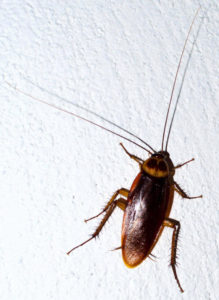 This species of roaches are also very tiny just like the German roaches. With just ½ to 5/8 in length, the color of these roaches ranges from light gold to glossy dark brown. It has yellow bands along the abdomen and on the base of wings which are more prominent on nymphs than on adults. These species also have wings but unlike German roaches are active flyers. Males are especially known to fly rapidly when agitated.
This species of roaches are also very tiny just like the German roaches. With just ½ to 5/8 in length, the color of these roaches ranges from light gold to glossy dark brown. It has yellow bands along the abdomen and on the base of wings which are more prominent on nymphs than on adults. These species also have wings but unlike German roaches are active flyers. Males are especially known to fly rapidly when agitated.
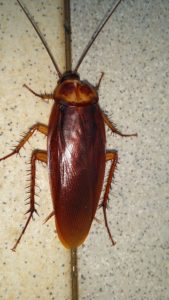 Adult American cockroaches are larger than German and Brown-banded roaches, measuring up to 1 ½ to 2 inches in length. Both male and female are reddish-brown with fully developed wings although they usually do not fly. The female American roaches need only to mate once to produce multiple oothecae as they can store sperm. Females drop their egg sacks within a couple of days after they are usually formed near water.
Adult American cockroaches are larger than German and Brown-banded roaches, measuring up to 1 ½ to 2 inches in length. Both male and female are reddish-brown with fully developed wings although they usually do not fly. The female American roaches need only to mate once to produce multiple oothecae as they can store sperm. Females drop their egg sacks within a couple of days after they are usually formed near water.
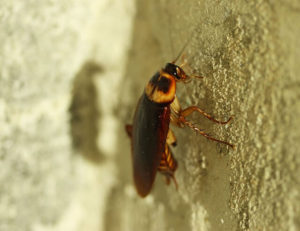 Oriental roaches are smaller than American roaches with the females measuring one ¼ inch while male oriental roaches measure just 1 inch in length. Although both male and females have wings, neither of them can fly. They are glossy brown or dark in appearance. Their lifespan is for six months.
Oriental roaches are smaller than American roaches with the females measuring one ¼ inch while male oriental roaches measure just 1 inch in length. Although both male and females have wings, neither of them can fly. They are glossy brown or dark in appearance. Their lifespan is for six months.






